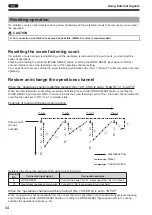
50
EN
Symptoms
Location to investigate
Solution
The output torque is
high
Screws are tightened
too much
Are you correctly combining the measuring
devices for measurement?
In addition, are the types of joint washers
(white rubber, black rubber, metal)
incorporated into screw joints, or the
incorporated sequence, correct?
Use a combination of NITTO KOHKI designated
measuring devices for measurement. (p. 8)
Check whether the screw joints are correct, and
perform measurement. (p. 10)
Has the permanent set in fatigue, cracks,
deformation, and hardening occurred in the
joint washers (white rubber, black rubber,
metal) incorporated into screw joints?
In cases where changes have occurred in the
rubber, there is a need to replace with new joint
washer parts.
Has the output torque changed?
The output torque changes over time.
Regularly check the output torque, and adjust the
setting torque. (p. 11)
Did you check the correlation between
the output torque occurred on screws
and the output torque measured using a
measurement device?
The output torque occurred on screws and the
output torque measured by the measurement
device are different.
Adjust the output torque according to the screw
fastening conditions. (p. 11)
Are there differences in the screw
fastening operation methods (operator,
force for handling or pressing the electric
screwdriver, fixing method, etc.)?
Torque conveyed to the motor current or screw
changes depending on the operations method.
Perform the screw tightening under fixed
operation conditions.
Has the temperature surrounding the
electric screwdriver, screw, or workpiece
changed?
Change in temperature can deform the workpiece,
stretch or loosen the screws, or cause changes in
the electric screwdriver characteristics.
Review the screw fastening conditions and
process.
Have you attached a heavy jig or a jig
having a large radius at the bit tip?
After the torque reaches the set torque, the inertial
force of the jig might have been transmitted to
screws.
Review the jig (make it lighter, make it smaller).
Are you performing an refastening or
tightening of short head length screws?
To ensure that a high torque is output, do not
perform these operations.
Perform adequate evaluations and verifications on
actual workpieces, and then use with caution.
Is this a soft start?
Torque control is not performed for soft start
(rotation speed rise in progress).
Lower the “soft start level” (No5 SOFT-START).
(p. 28)
In the case of a “HARD” fastening setting,
has the fastening time elapsed?
After the fastening time has elapsed, and switched
to the seating speed, set the “fastening timer”
(No.7 FSTN-T) value shorter.
The output torque
graph and actual
output torque do not
match
The graph value is standard. The output torque range is not guaranteed. The output torque
range sometimes differs from the graph but this is not a product error. (p. 11)
The speed setting
value and actual
speed do not match
Speed setting value is a standard for no-load speed. The actual speed is not guaranteed. The
actual speed sometimes differs from the setting value but this is not a product error. (p. 11)
Note, if the electric screwdriver motor is warm, it has the property of free speed rising.
Is it reverse rotation?
Reverse rotation rotates at the maximum speed.
Is this a “HARD” fastening setting?
The setting speed rotates for just the fastening
time period only.
If the fastening time is exceeded, it automatically
switches to the seating speed.
Is the “fastening timer” (No.7 FSTN-T) set?
The speed is not
stable
Is the electric screwdriver generating heat?
Is this the case where a load is applied to
the bit area?
Is this the case of a comparison with a
separate electric screwdriver?
The specification value and setting value is
standard.
The speed of electric screwdrivers varies
depending on the temperature of the unit,
mechanical loss and grease conditions.
If a load is applied to the bit part, the speed drops.
In addition, the electric screwdriver speed includes
a solid differential. (p. 11)
Appendix
TV07783-1_DLV10C_en.indb 50
2017/06/27 17:41:42














































